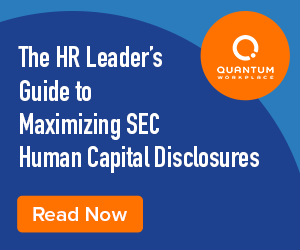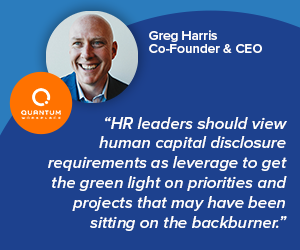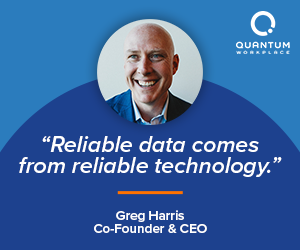
The pressure is building around SEC human capital disclosures. Investor groups aren’t satisfiedwith what they’ve seen so far and are already pushing the SEC to require more robust, consistent disclosures that help them make better investment decisions.
The current, principles-based guidance is intentionally vague. Consequently, many CHROs and business executives have been playing it safe and taking a “wait and see” approach.
But now is the time to start making moves–to get ahead of the inevitable shift in expectations.
“This is a massive opportunity for HR leaders to demonstrate the value of their work, and for organizations to win the hearts and minds of shareholders,” says Greg Harris, Co-Founder and CEO of Quantum Workplace.
Here are 3 ways CHROs should evolve their approach as human capital disclosure requirements continue to evolve.
1. Capitalize on the increased attention around human capital.
The events of 2020 were transformational for HR–and HR teams across the globe have stepped up to the plate in big ways. Many HR leaders are overwhelmed, buried in more diverse priorities than ever before. And human capital disclosures may be at the bottom of the list.
But as investors continue to understand the value of human capital reporting and push for more transparency, there’s a lot of opportunity for HR leaders to elevate their status.
Become a strategic partner to the business.

This is a pivotal moment for the CHRO, who will now be seen as an equal partner in steering the business. Decision makers will be paying attention to what the CHRO is doing–and looking to HR to advise on what information the business should disclose, why, and how.
Demonstrate your value to your leaders and peers.
With increased visibility into HR’s impact on the business, this is a strategic opportunity for HR to gain credibility and show their contributions to the bottom line.
“Ready or not, human capital is top of mind for your CEO–and HR leaders will be on the front lines of sweeping change for the next several years,” says Harris.
Get the support and buy-in you need.
CHROs now have a major platform to get the support and buy-in they need from leaders. Collecting data, analyzing it, reporting on it, and showing progress on any given metric all require significant investment and commitment across the business.
“HR leaders should view human capital disclosure requirements as leverage to get the green light on priorities and projects that may have been sitting on the backburner,” says Harris.
2. Elevate your HR strategy to create & communicate long-term business value.
As the C-suite becomes more attuned to investor expectations around disclosures, HR will need to level up their data, reporting, and storytelling skills.
“HR will need to better align their work with key business objectives and make a foolproof connection between the success of employees and the success of the business,” says Harris.
When drawing the connection between HR strategies and business strategy, ask:
- What do our people programs look like?
- Why did we put them into place?
- How are we measuring success?
- What business KPIs do they impact?
- Will these programs increase trust with employees, leaders, and investors?
Organizations might be able to get by with simply reporting on people metrics for a little while longer, but investors will expect to see improvement on those metrics over time. And without the context behind your metrics, investors will be asking questions.
“CHROs will need to create reports that reflect the reality of their human capital truthfully and accurately–and put strategies in place to move the needle on these parameters,” says Harris.
Context will be key in helping organizations tell a story that helps investors make informed, data-driven decisions. CHROs should be thinking beyond metrics–and they’ll need to decide what matters most to the business and what they think might impact shareholder support.
Some guiding questions to help build context might include:
- What makes your organization unique?
- What makes it competitive?
- What risks exist and how are you addressing them?
“Building a thoughtful and strategic narrative with your human capital disclosures can help position your business ahead of the competition,” says Harris. “It shows shareholders how committed you are to improvement and to cultivating a successful workforce.”
3. Equip yourself with the right data, intelligence, and technology.

When it comes to human capital disclosures, organizations will need to prioritize accuracy, efficiency, and impact. To meet these objectives, CHROs need to be ready to come to the table with relevant data and insights.
This will require different tools and technology than what many HR leaders are equipped with today. Organizations won’t be able to get by with spreadsheets, disjointed data, and basic HR information systems. It opens the business to too much risk.
“Any information you disclose in your filings is going to be auditable, so the integrity of your data is important,” says Harris. “Reliable data comes from reliable technology.”
HR teams should reexamine their tech stacks–and business leaders should be ready and able to back investments in new technology.
The right HR technology stack will help your organization:
Collect and analyze real-time, quality data on key human capital metrics.
In today’s pace of business, change happens fast. You need tools that help you capture, analyze, and store your data in real-time. This empowers you to use data for key decisions and strategy–and will make your human capital reporting much easier and more efficient.
Uncover critical, actionable insights that will help drive improvements.
You’ll want to be deeply connected to your data. But you shouldn’t have to do all the hard work. Look for tools that use automation and AI to help surface insights from your data. The right technology can help you nudge the right person, at the right time, to take the right action.
Increase access to data, analytics, and insights to anyone who needs it.
Your disclosures will likely be shaped by the perspectives and priorities of a variety of business unit leaders. Those leaders should all have access to the same information. Make sure your tech stack includes people analytics tools that enable access to anyone who needs the data.
Help leaders understand benchmarks and progress over time.
You won’t want to do a manual data pull every quarter. Your tools should help you easily visualize progress and trends so you can benchmark against yourself over time and quickly understand the right stories to tell. Bonus: look for tech that also helps you benchmark your people metrics against other companies like you.
Move the needle on the HR metrics that drive employee and business success.
People analytics tools are a must-have. But you also need tools that help you cultivate a successful workforce. Prioritize investments in platforms that help you drive engagement, boost performance, and facilitate growth and development. Pro tip: when you layer the data from all these tools, you’ll be able to pull the right levers at the right time–and tell a powerful story.
* Produced by Human Resource Executive and Sponsored by Quantum Workplace, to learn more visit quantumworkplace.com/hre.


